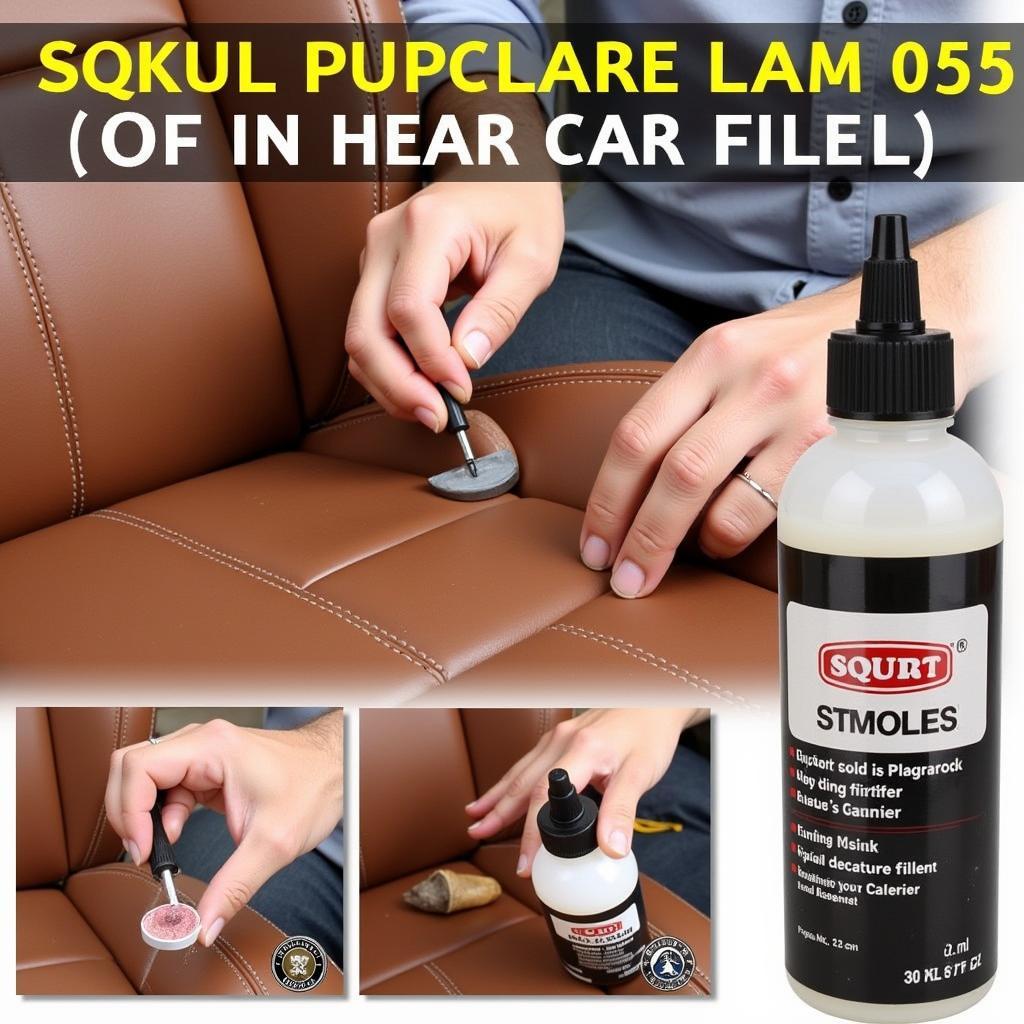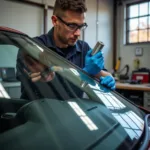Leather car seats add a touch of luxury and comfort to any vehicle. However, they can be susceptible to damage, such as holes, from everyday wear and tear. Knowing how to repair a hole in a leather car seat can save you from costly replacements and maintain the pristine look of your interior. This guide will walk you through various repair methods, from DIY fixes to professional solutions.
Repairing a hole in your leather car seat doesn’t have to be daunting. With the right tools and techniques, you can restore your car’s interior to its former glory. Let’s explore the different options available. how to repair a hole in leather car seats
Understanding the Damage: Types of Holes and Repair Approaches
Before diving into the repair process, it’s crucial to assess the damage. Different types of holes require different approaches. Small punctures, for example, can often be fixed with a simple leather filler, while larger tears might need patching. Burns require a slightly different approach, often involving sanding and refinishing.
Small Punctures and Tears
These are typically caused by sharp objects like keys or pens. For minor punctures, a liquid leather filler can be used to fill the hole and blend seamlessly with the surrounding leather.
Larger Tears and Rips
More extensive damage, like rips or tears, often requires a patch. Leather repair kits usually include patches and adhesive designed specifically for leather. Matching the color and grain of the leather is essential for a seamless repair.
Burn Holes
Burns from cigarettes or other hot objects can be tricky. They often require sanding down the damaged area before applying filler and a color-matched finish.
DIY Leather Car Seat Repair: A Step-by-Step Guide
For minor damage, a DIY approach can be both cost-effective and convenient. Here’s a step-by-step guide on how to repair a hole in a leather car seat using a leather repair kit:
- Clean the Area: Thoroughly clean the damaged area with a leather cleaner to remove dirt and debris.
- Prepare the Hole: If the hole has frayed edges, carefully trim them with small scissors.
- Apply the Backing Fabric (if needed): For larger tears, apply the backing fabric included in the kit to the underside of the hole.
- Fill the Hole: Apply the leather filler to the hole, building it up in thin layers. Allow each layer to dry completely before applying the next.
- Sand and Smooth: Once the filler is dry, sand it down with fine-grit sandpaper until it’s flush with the surrounding leather.
- Apply the Colorant: Carefully apply the leather colorant, matching it as closely as possible to the original color. Multiple thin coats are better than one thick coat.
- Apply the Finish: Apply a leather finish to protect the repair and restore the leather’s natural sheen.
When to Call a Professional
While minor repairs can be tackled at home, more significant damage or complex repairs might require professional expertise. How to repair a hole in a leather car seat can be a challenging task, especially if the damage is extensive or in a prominent location. Professionals have the experience, tools, and knowledge to handle complex repairs seamlessly.
“For deep cuts or tears, especially those involving the stitching or structural elements of the seat, it’s always best to consult a professional,” says renowned automotive upholstery expert, John Miller. “They can assess the damage accurately and recommend the best course of action, ensuring a lasting and aesthetically pleasing repair.”
Preventing Future Damage: Tips for Maintaining Your Leather Car Seats
Prevention is always better than cure. Regular cleaning and conditioning can help prevent holes and other damage to your leather car seats.
- Regular Cleaning: Wipe down your seats weekly with a damp cloth and a dedicated leather cleaner.
- Conditioning: Apply a leather conditioner every few months to keep the leather supple and prevent cracking.
- Protect from Sharp Objects: Be mindful of sharp objects like keys and pens that can puncture the leather.
- Use Seat Covers: Consider using seat covers, especially if you frequently carry pets or cargo.
Conclusion
Learning how to repair a hole in a leather car seat can save you money and preserve the beauty of your car’s interior. Whether you opt for a DIY fix or seek professional help, addressing the damage promptly is key to preventing further deterioration. By following these tips and techniques, you can keep your leather car seats looking their best for years to come. How to repair hole in leather car seats provides comprehensive information and resources to help you maintain your car’s interior.
FAQ
-
Can I use super glue to repair a tear in my leather car seat? While tempting, super glue is not recommended for leather repair. It can create a stiff, inflexible bond that can crack over time.
-
What is the best leather filler for car seats? Look for a high-quality leather filler specifically designed for automotive leather. It should be flexible, durable, and color-matchable.
-
How long does it take for leather filler to dry? Drying times vary depending on the product, but most fillers dry within a few hours.
-
How can I prevent my leather car seats from fading? Park your car in the shade whenever possible and use a UV protectant spray to shield the leather from the sun’s harmful rays.
-
How often should I condition my leather car seats? Conditioning every three to six months is generally recommended to keep the leather supple and prevent cracking.
-
Can I repair a burn hole in my leather car seat myself? Minor burn holes can often be repaired with a DIY kit. However, deeper burns might require professional attention.
-
Where can I find a reputable leather car seat repair shop? Check online reviews and ask for recommendations from local car dealerships or auto detailing shops.
Other helpful resources on our website:
Need assistance? Contact us via WhatsApp: +1(641)206-8880 or Email: [email protected]. Our customer support team is available 24/7.



